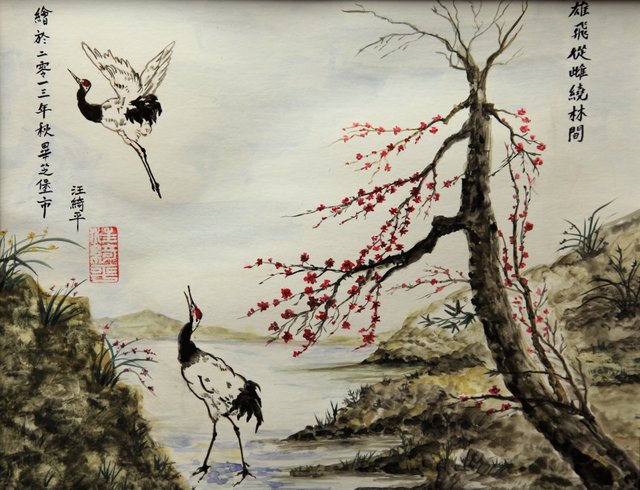
Source

Ok, here we are with another advanced practice. The instructions are quite straight forward, just create a text and share it in a comment or in another post in order to practice all the new and past learning material. It will get interesting as the practices keep coming since each text should contain all the learning material from the former practices
New learning material
Image source
The structure “又……又……”: The structure 又adj1 + 又adj2……is used to indicate that two qualities are present simultaneously on a person of an object。For example: 这个芒果又大又甜。
The structure “V1着(Obj1) + V2(Obj2)" : In Chinese the structure “V1着(Obj1) + V2(Obj2)" indicates two actions taking place at the same time, usually V1 is the accompanying state or manner of V2。 For example: 他们站着聊天儿。
Image source
Nouns:服务员,客人,超市,比赛,照片,蛋糕,年级,年轻
Verbs:回答,站
Adjectives:聪明,努力,俄,认真
Adverbs:又,总是

After more than 70 posts in our daily writing practices 💪 after learning a few characters and fairly simple sentences, now we are upgrading our studying activities to the next level!! Let's keep walking together in this never-ending journey my friends!

Gif source
Users who would like to participate can start whenever he/she wants, we have a few students that just happen to be the first ones to be interested in learning Chinese. I guarantee that ANYONE interested in learning Chinese will also get WLS from me while doing it! I think that further incentivizing people to learn useful stuff is a good way to use my stake on Whaleshares. Besides, if past lessons posts' payout already expired, the potential new users and I could just continue the trend in the comment section since each comment is essentially a new post.
Previously studied learning material
Image source
Comparison of “还是” and “或者”: Both “还是” and “或者” are used to connect choices. “还是” is used in interrogative sentences, and “或者” in the declarative senteces。For example: 你想妈了一台电脑还是一个手机。你能走左边或者右边。
For sentences with interrogative clauses only “还是” can be used in the clause。For example: 你要不要喝果汁还是可乐。
The expression of existence: location word + V着 + Numeral + Measure Word + Noun: In Chinese the structure "Location Word + V着 + NP" means there is something somewhere. Also, the noun phrase is usually an indefinite object, for example “一本书” and “几个人” and “这本书” and “马老师”。 For example: 桌子上有几瓶酒。
Indicating the possibility “会”: The auxiliary verb “会” is used in a sentence to indicate the possibility, usually referring to something that has not happened. For example: 别担心,我会准时来。
Verb + 去/来 indicates the direction of an action: In Chinese "去" indicates that something occurs moving away from the speaker while "来" indicates that something occurs towards the speaker. Some of the most frequently used verbs in this structure are 上,下,进,出,回,过,起,买,带,搬。For example: 那位是他的妹妹吗?你出去看看。(Away from the speaker)
If the object of the verb is a place it should precede 去/来。For example: 我女朋友我家房子来
If the object is a thing it can be put either after or before 去/来。For example: 下次去商场玩儿,你要带来你在中国买的车。
The successive occurrance of two actions: The structure "Verb1 + 了……就 + Verb2“ is used to indicates two actions that occur successively, the first occurred action correspond to the first verb. For example: 今天我起了床就把电脑打开。
In a sentece with two subjects, the second subject should be placed right before “就”. For example: 我儿子上了课我就回家。
The rhetorical question “能……吗?”: “能……吗?” is used as a rhetorical question in Chinese, the positive structure conveys a negative meaning while the negative structure conveys an affirmative meaning. For example 你觉得为什么他没到?可是因为这星期她要考四个考试,她能有空吗?
The complement of result “好”: the complement of result “好” follows a verb to indicate that the action has been satisfactorily completed. For example 我复习好了昨天的课。
The negative structure “一………也/都+不/没+V”: The negative structure “一+Measure word+Noun+也/都+不/没+V (not at all)" indicates complete negation. For example 我一个手机也没买了。 Sometimes the “一+Measure word” is replaced with "一点儿”。For example 这个月我忙极了,一点儿时间也没有。 When the predicate is an adjective, the structure "一点儿也/都+不+Adj." is used to indicate the complete negation. For example 你怎么一点儿也不知道?
The conjunction “那”: 那 is used at the beginning of a sentence to indicate the result obtained from the previous action, or to express the logic result of the aforementioned condition. For example 我不想去吃外边,那我就做做水果饭
Image source
Nouns:周末,打算,游戏,作业,南方,北方,面包,地图,腿,脚,树,太太,秘书,经理,办公室 ,楼,伞,裤子,衬衫,饮料,花
Verbs:打算,复习,带,搬,拿, 爬山,记得,放
Adjectives:着急,胖,容易,难 ,瘦,小心,新鲜,甜,舒服,绿
Adverbs:一直,其实,只
Conjuction:还是,或者
Prepositions:跟
Classifiers:辆,把,条,元
Particles:啊
Word Count: 66
Grammatical structures count: 11
Previous Practices
Advanced reading and writing practices
First week: 1, 2, 3 |

Beginner reading and writing practices
First week: 1, 2, 3, 4, 5, 6 | Second week: 7, 8, 9, 10, 11 | Third week: 12, 13, 14, 15, 16 | Fourth week: 17, 18, 19, 20 | Fifth week: 21, 22, 23, 24, 25 | Sixth week: 26, 27, 28, 29, 30, 31, 32 |
Seventh week: 33, 34, 35, 36, 37, 38, 39 | Eight week: 40, 41, 42, 43, 44, 45, 46, | Ninth week: 47, 48, 49, 50, 51, 52, 53 | Tenth week:54, 55, 56, 57, 58, 59, 60 | Eleventh week:61, 62, 63, 64, 65, 66, 67 | Twelfth week:68, 69, 70 |

Feel Free to Join the Discord Server of Whale Academy

Greetings
☯ ☯ ☯ ☯ ☯ ☯ ☯ ☯ ☯

Thanks for using eSteem!
Your post has been voted as a part of eSteem encouragement program. Keep up the good work! Install Android, iOS Mobile app or Windows, Mac, Linux Surfer app, if you haven't already!
Learn more: https://esteem.app
Join our discord: https://discord.gg/8eHupPq
Downvoting a post can decrease pending rewards and make it less visible. Common reasons:
Submit
Hi, @joelsegovia!
You just got a 2.46% upvote from SteemPlus!
To get higher upvotes, earn more SteemPlus Points (SPP). On your Steemit wallet, check your SPP balance and click on "How to earn SPP?" to find out all the ways to earn.
If you're not using SteemPlus yet, please check our last posts in here to see the many ways in which SteemPlus can improve your Steem experience on Steemit and Busy.
Downvoting a post can decrease pending rewards and make it less visible. Common reasons:
Submit